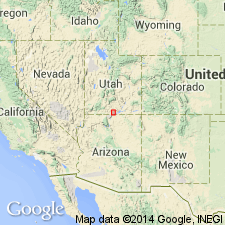
- Usage in publication:
-
- Tibbet Canyon Member*
- Modifications:
-
- Named
- Dominant lithology:
-
- Sandstone
- AAPG geologic province:
-
- Plateau sedimentary province
Summary:
Named as basal member of Straight Cliffs Formation for exposures on east side of southeast-trending spur on north side Tibbet Canyon, Kane Co, UT in Plateau sedimentary province. Type section measured in N1/2 NE1/4 NE1/4 sec 14, T42S, R3E. Composed of yellowish-gray to grayish-orange, very fine- to medium-grained, horizontally stratified and cross-stratified sandstone. Forms cliffs and slabby cliffs. Is 104 ft thick at type section; ranges from 70-185 ft thick. Intertongues with underlying Tropic Shale; lower contact placed at base of lowest persistent sandstone. Upper contact usually sharp; is placed at top of cliff-forming sandstone below mudstone and coal of Smoky Hollow Member. Was called lower sandstone member of Straight Cliffs Formation by Peterson and Waldrop (1965). Deposited in beach and shallow-marine environment (inoceramids, cephalopod, shark teeth, and Ophiomorpha fossils). A middle Turonian, Late Cretaceous age indicated.
Source: GNU records (USGS DDS-6; Denver GNULEX).
For more information, please contact Nancy Stamm, Geologic Names Committee Secretary.
Asterisk (*) indicates published by U.S. Geological Survey authors.
"No current usage" (†) implies that a name has been abandoned or has fallen into disuse. Former usage and, if known, replacement name given in parentheses ( ).
Slash (/) indicates name conflicts with nomenclatural guidelines (CSN, 1933; ACSN, 1961, 1970; NACSN, 1983, 2005, 2021). May be explained within brackets ([ ]).

